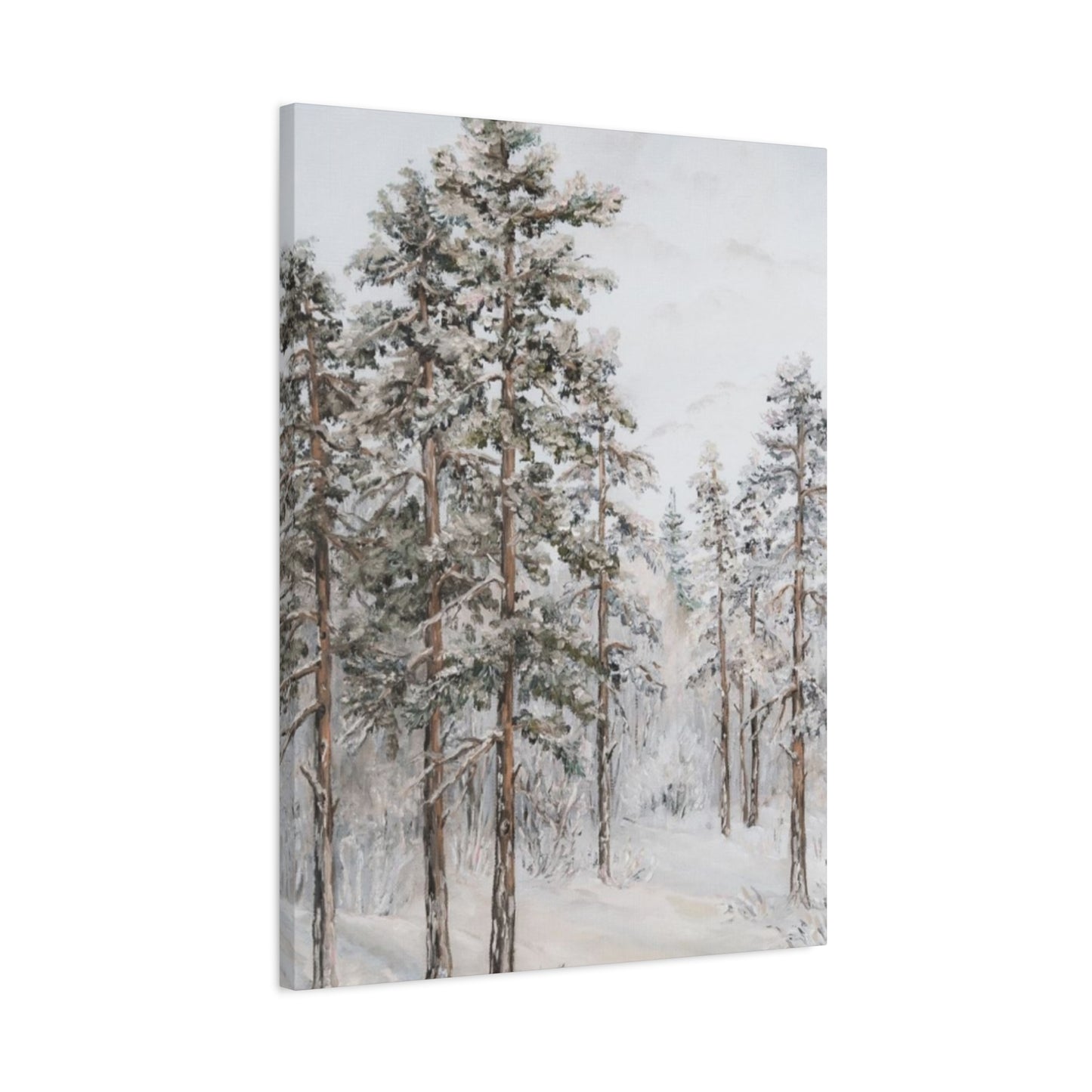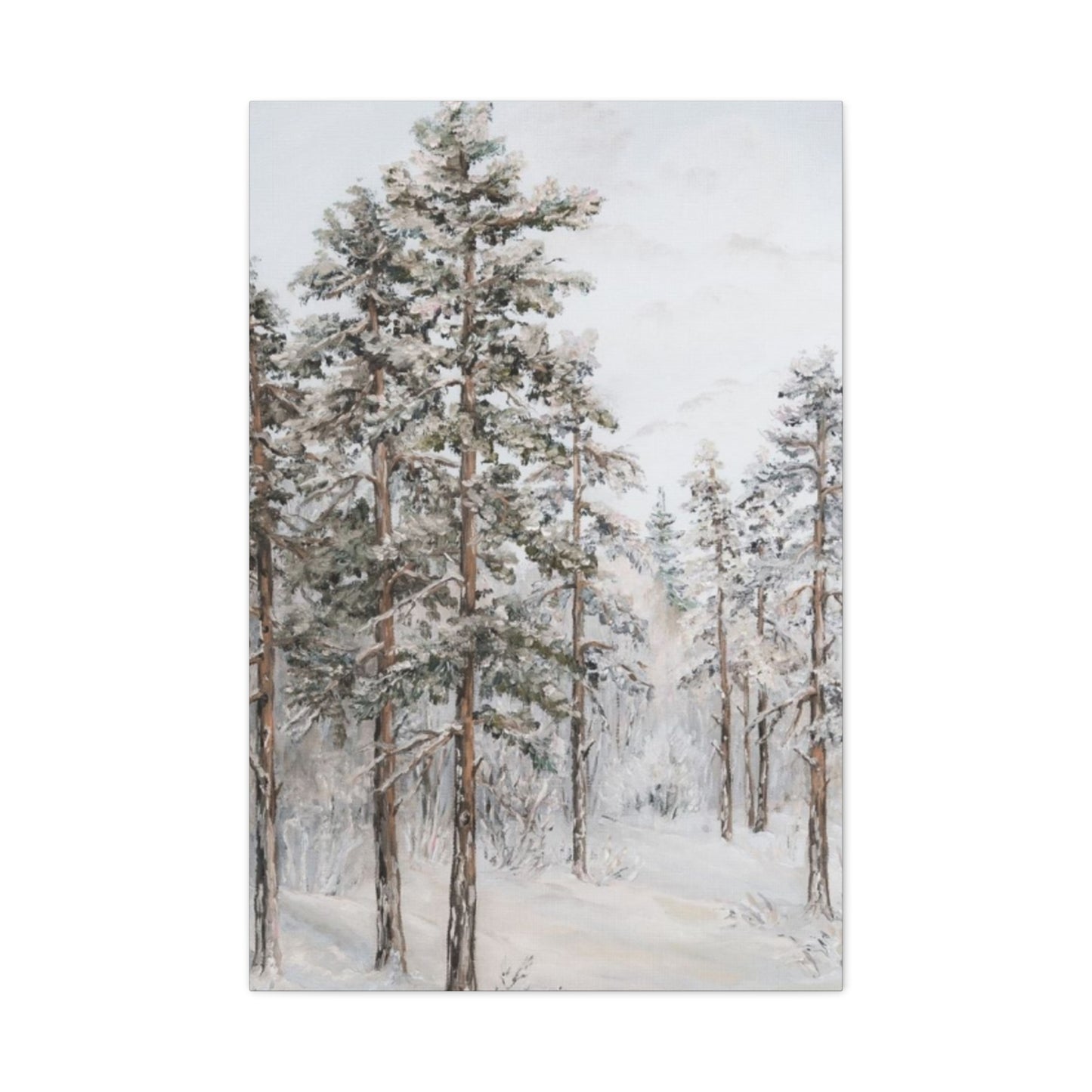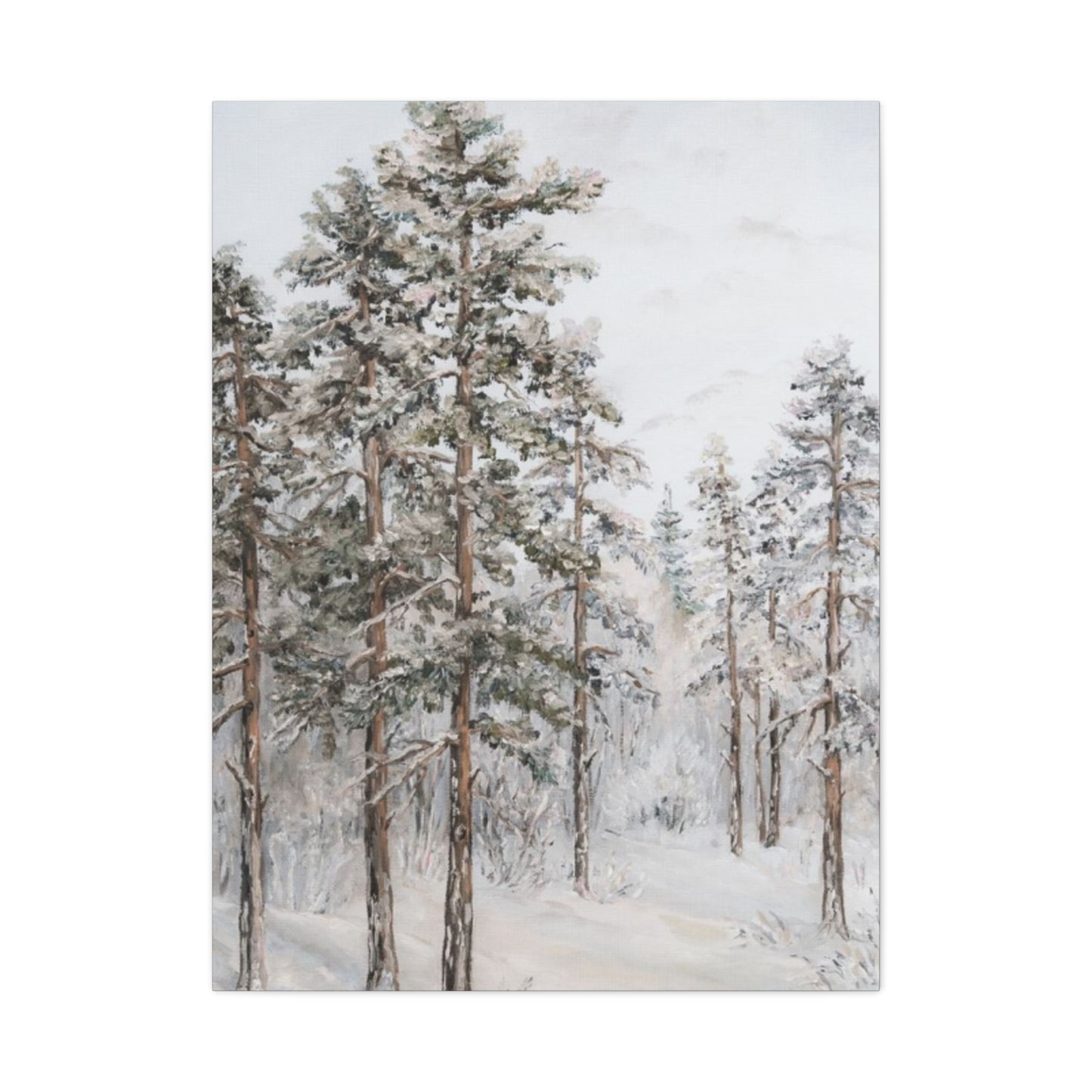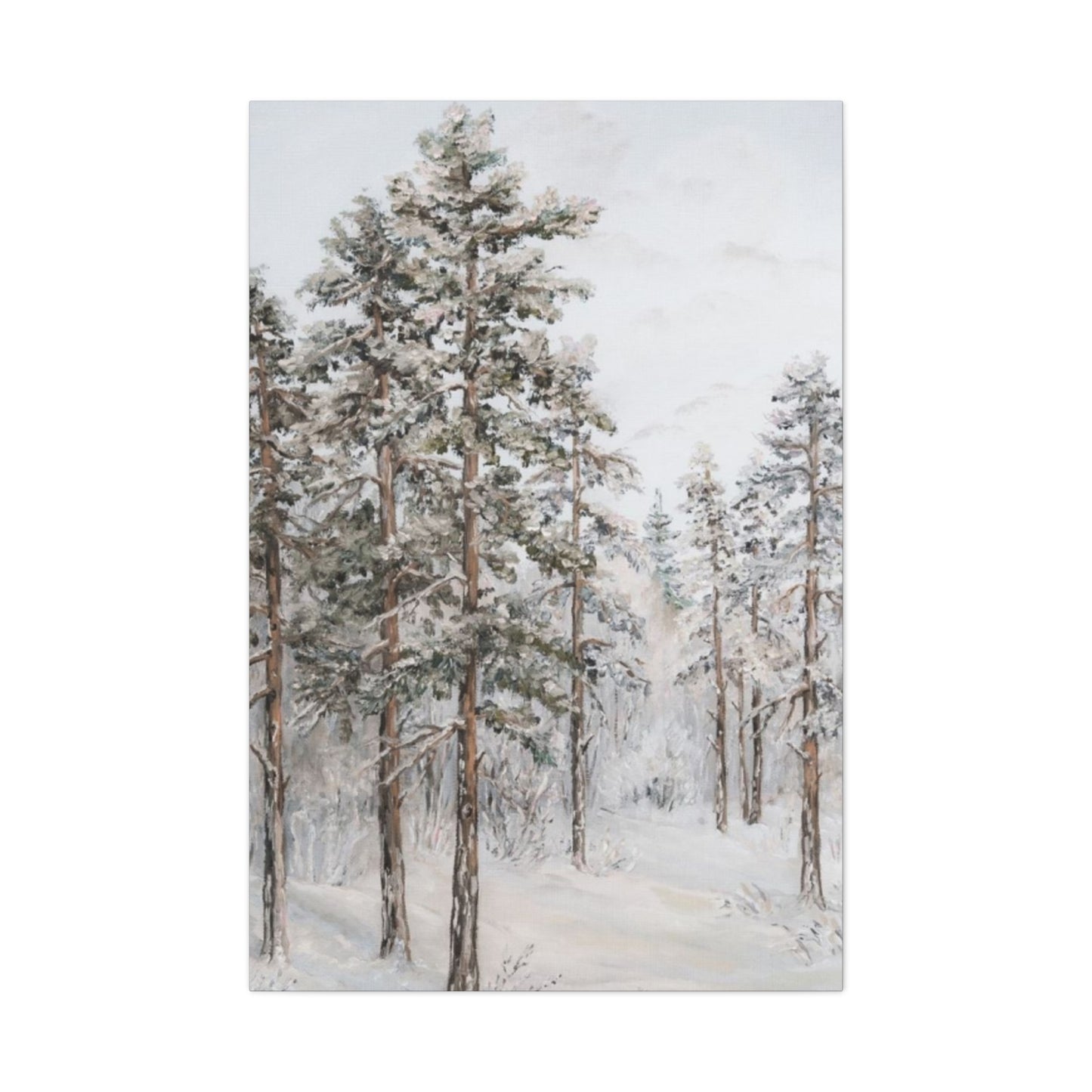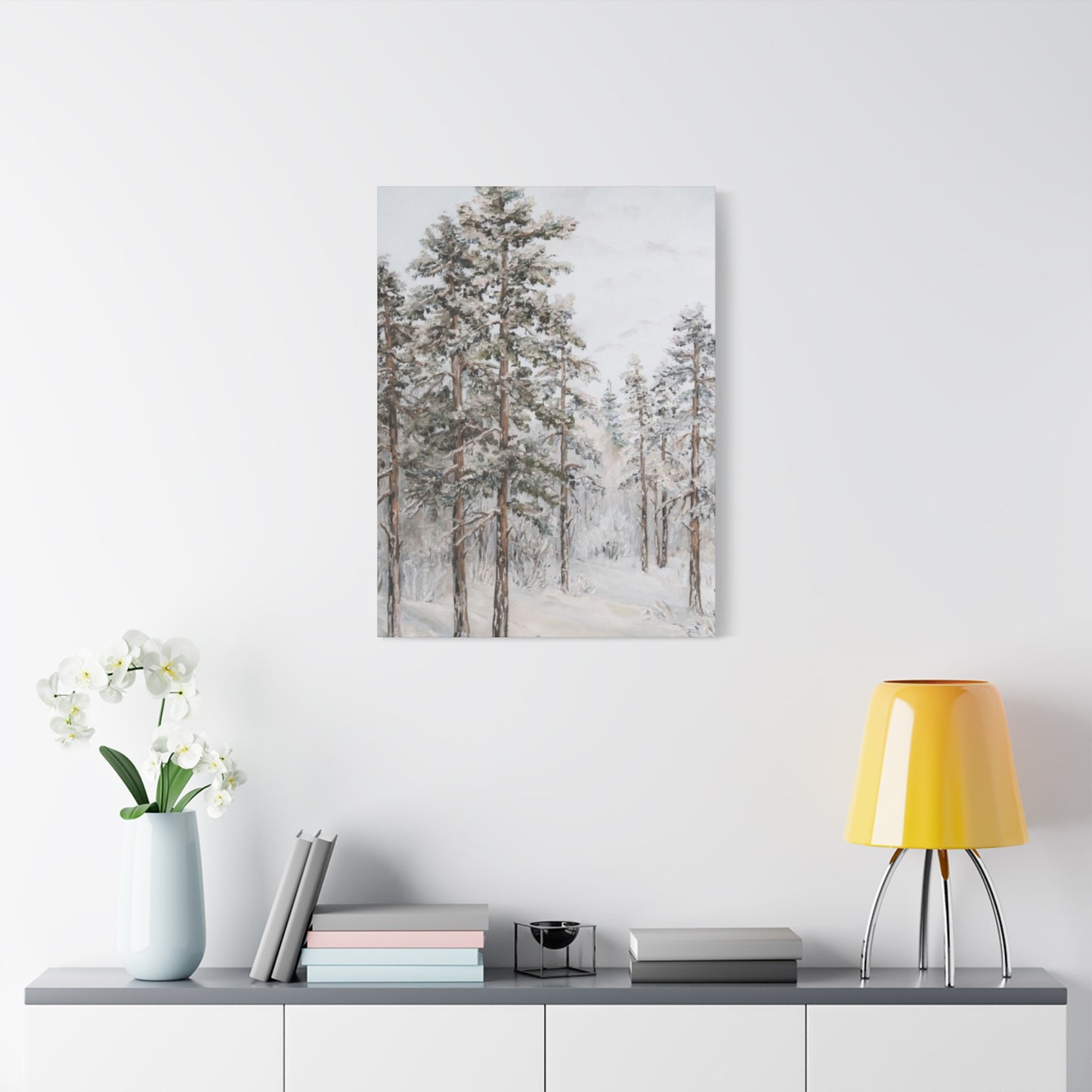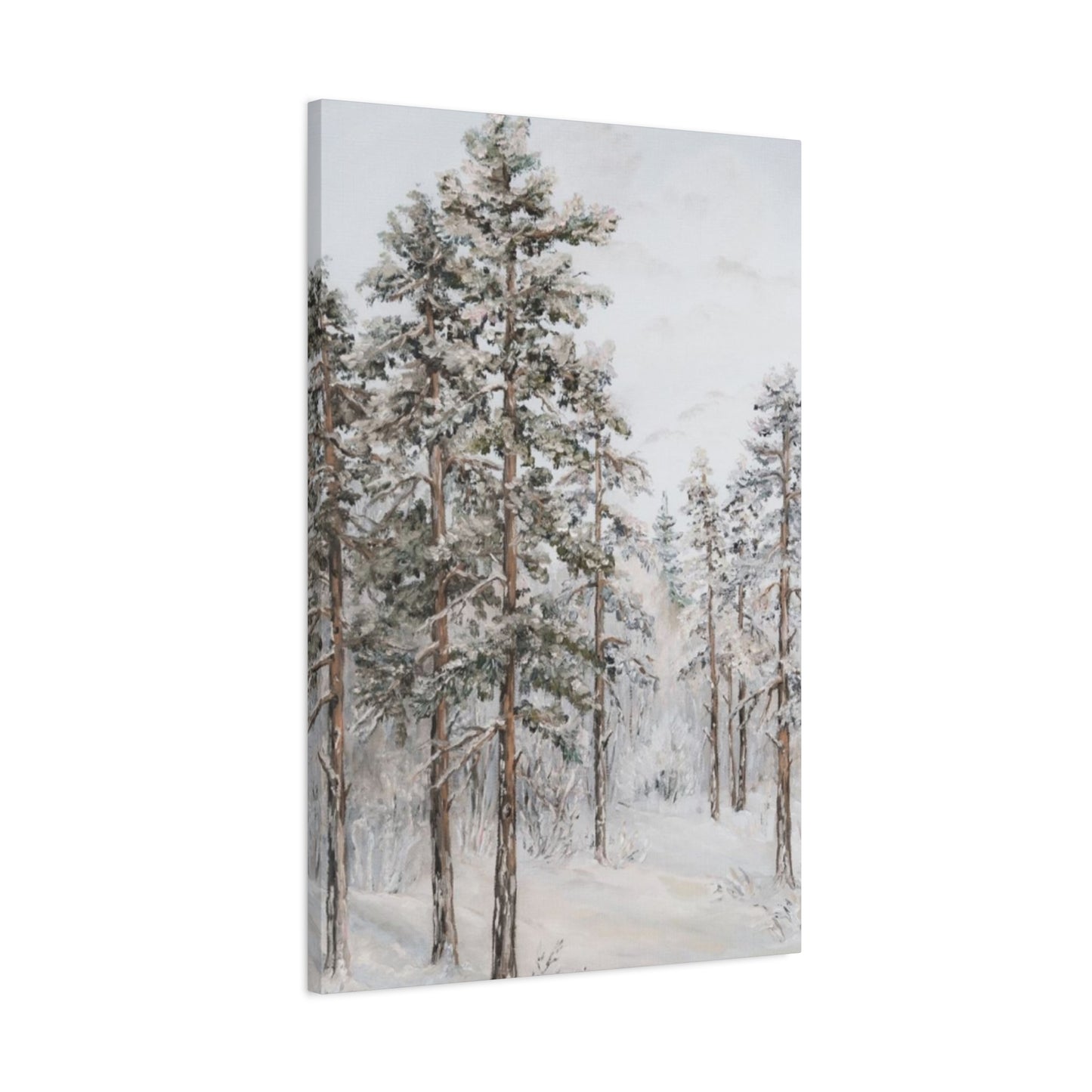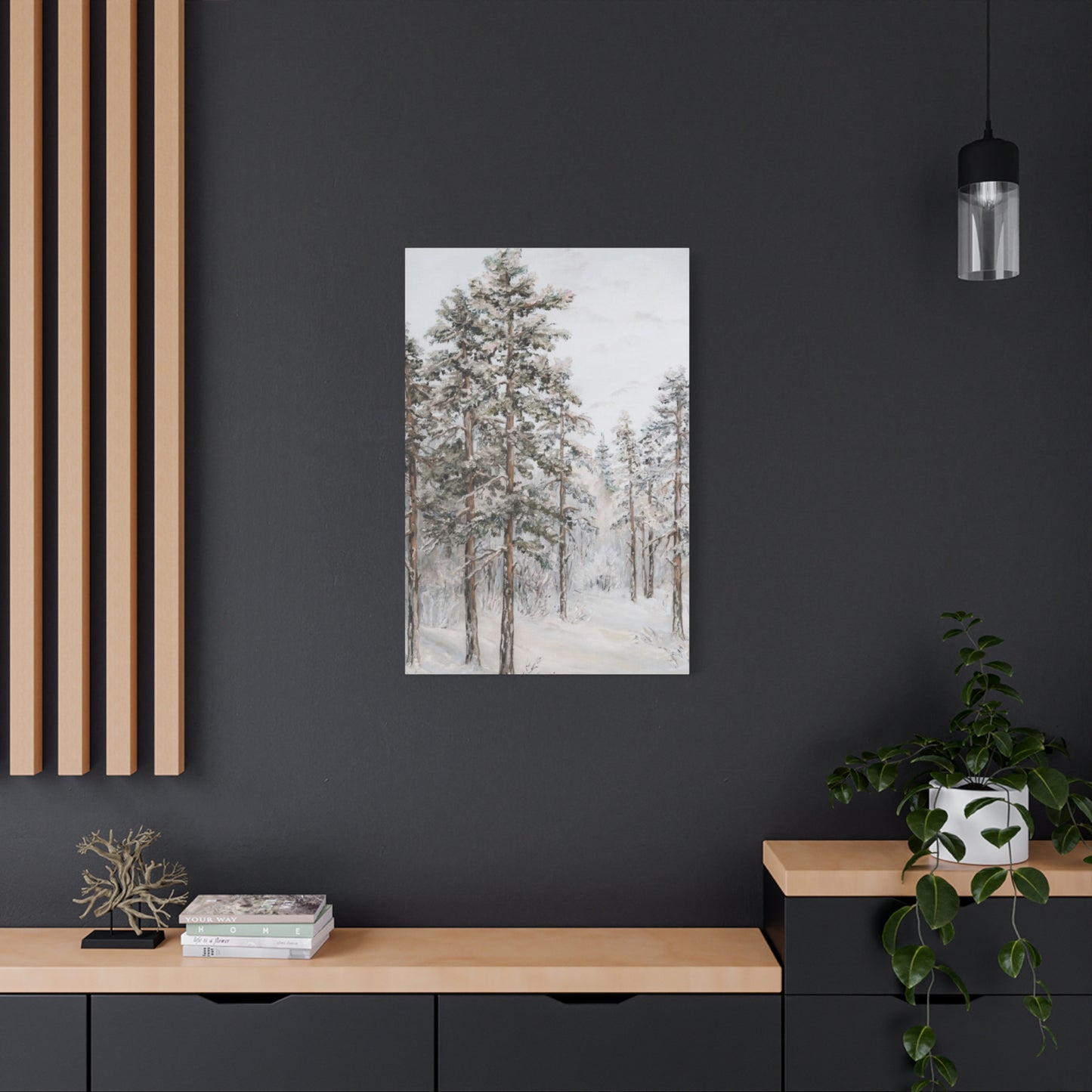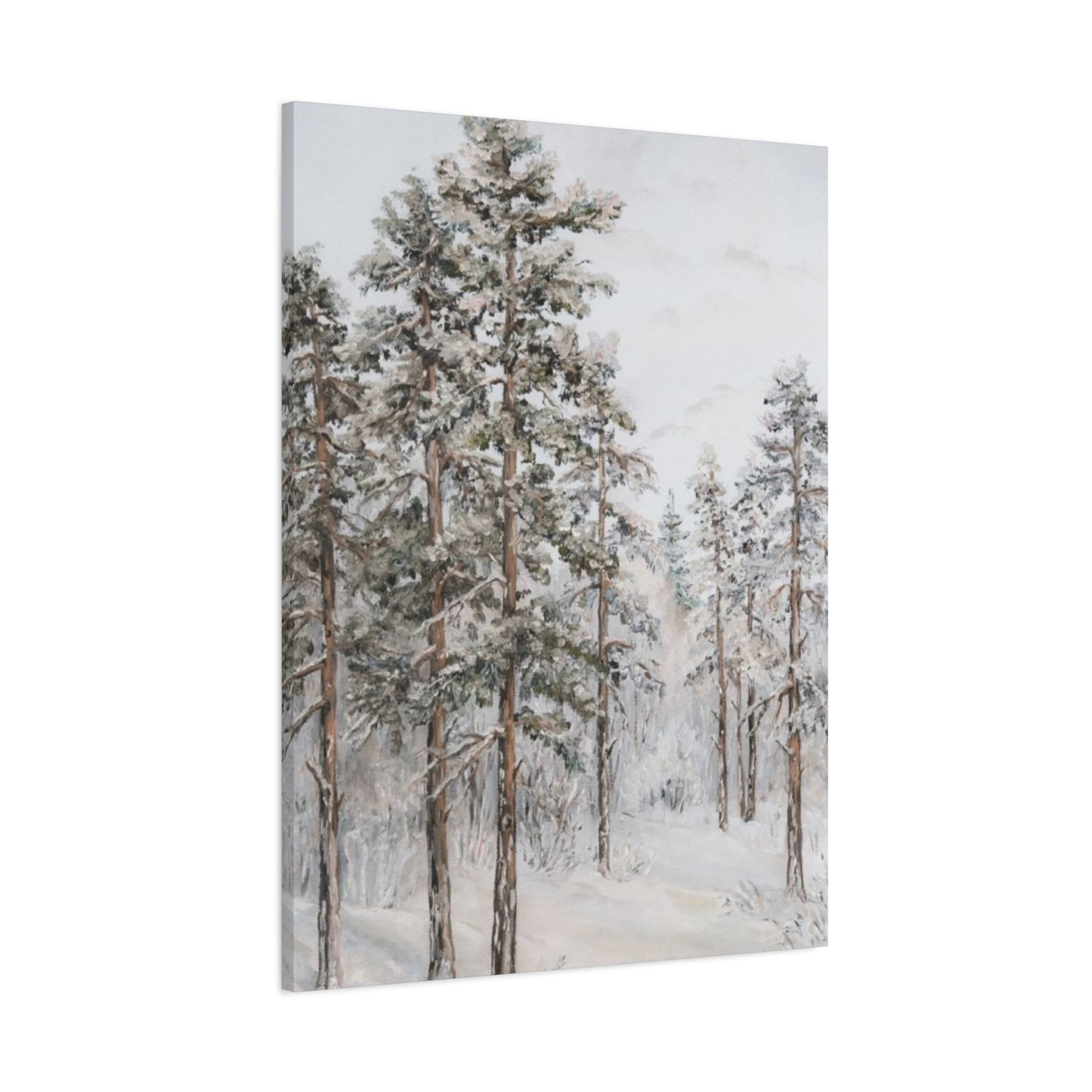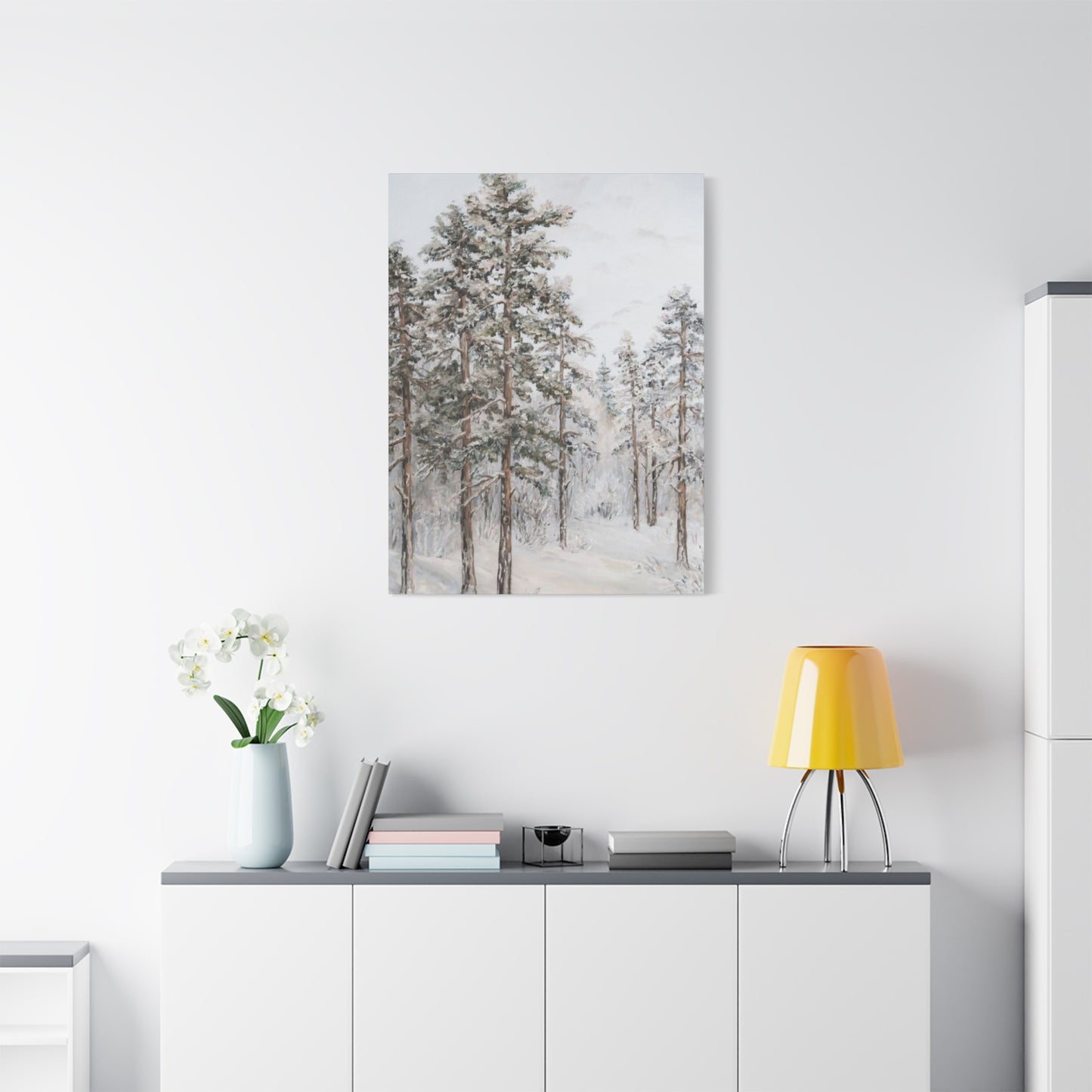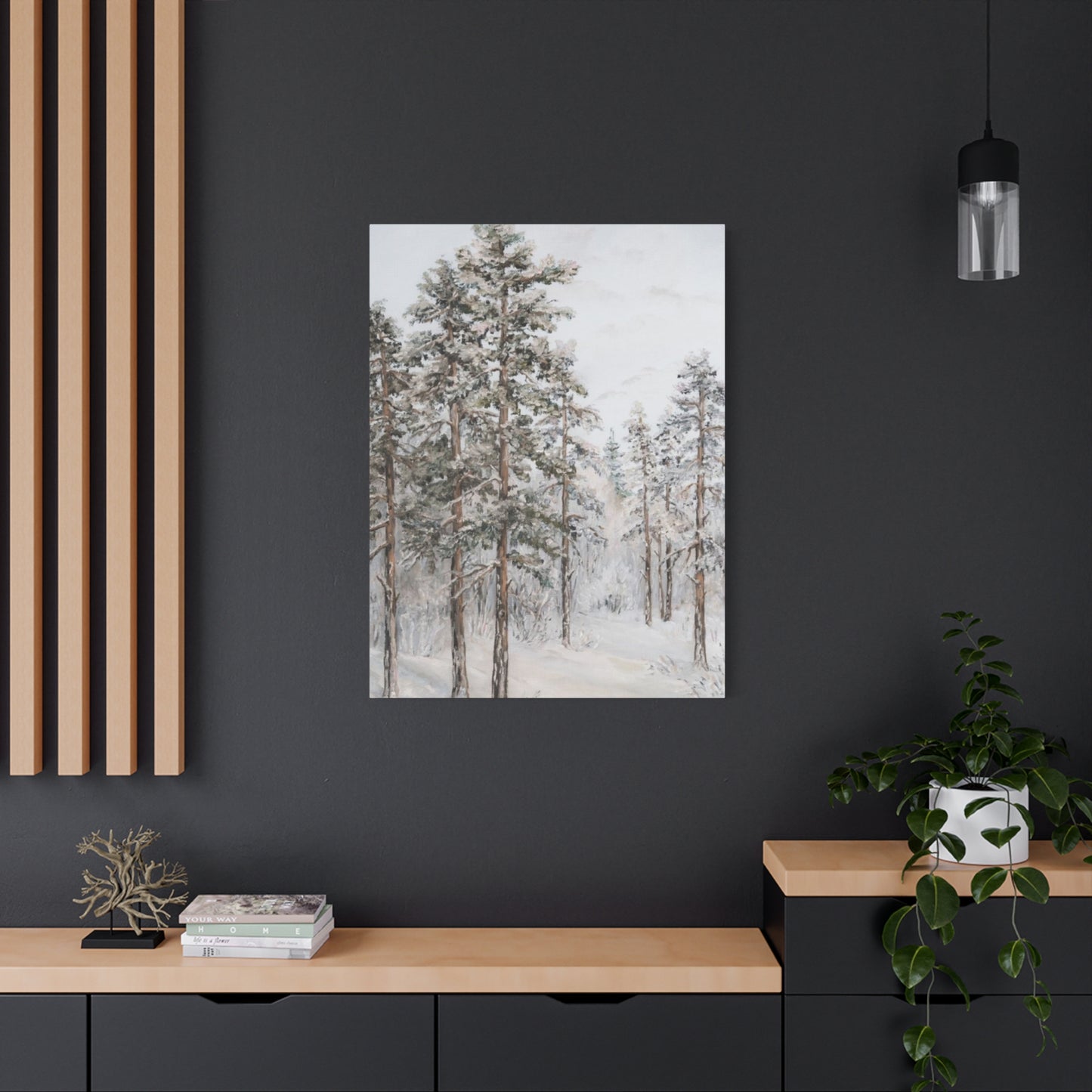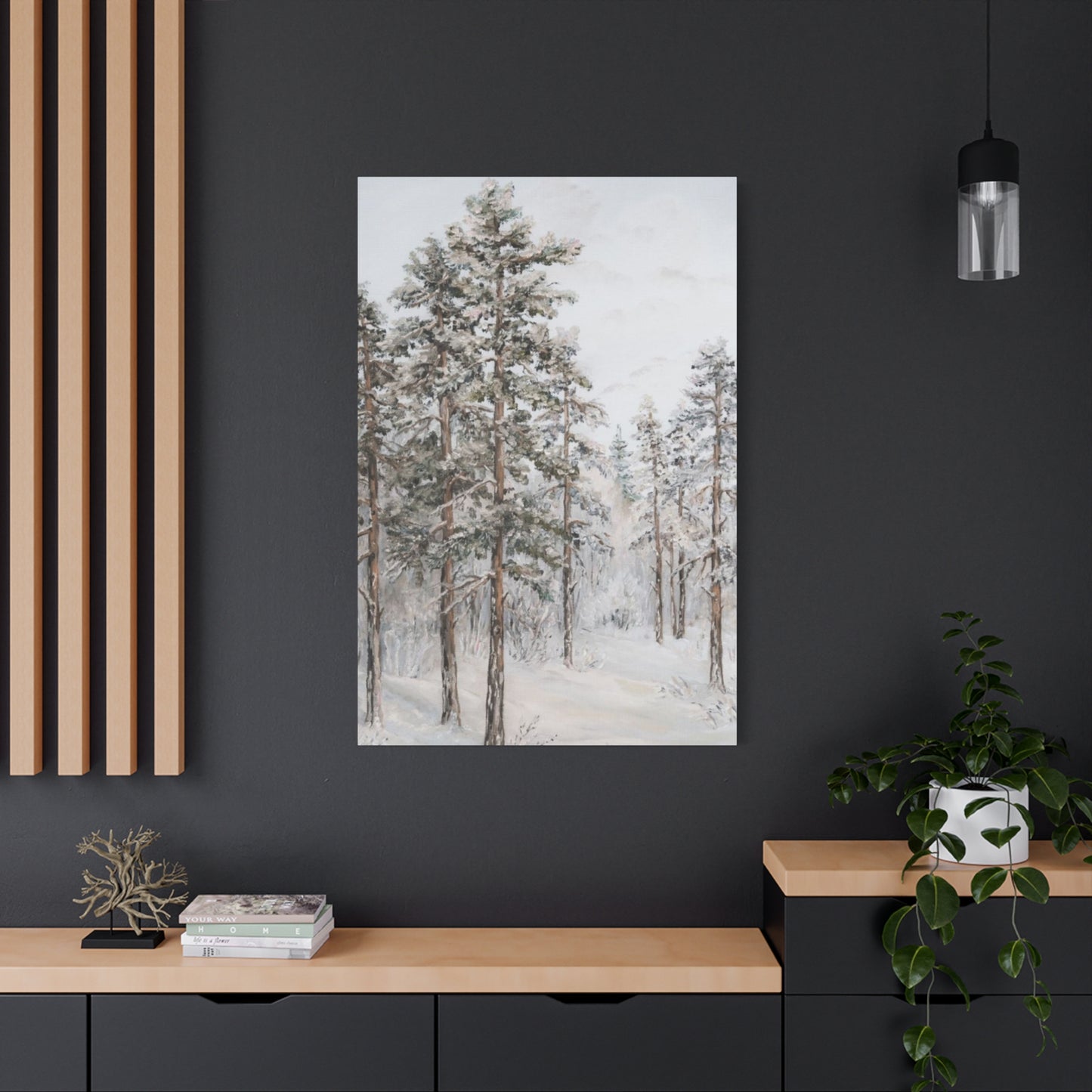Winter Serenity: How Snow Forest Wall Art Creates a Peaceful Home Atmosphere
The enchantment of wintry landscapes has captivated artists and interior design enthusiasts for generations. When snowflakes blanket dense woodlands and frost transforms ordinary branches into crystalline masterpieces, nature creates scenes of extraordinary beauty that deserve to be celebrated within our living spaces. Canvas prints featuring these pristine winter scenes offer homeowners an opportunity to bring the hushed magic of cold-weather forests directly into their rooms, creating atmospheres of peace and contemplation that few other decorative choices can match.
Snow-covered forest artwork serves multiple purposes beyond simple decoration. These pieces function as windows into serene natural environments, offering visual respites from the hectic pace of modern life. When thoughtfully selected and properly displayed, winter woodland prints can dramatically alter the emotional temperature of a room, introducing elements of calm sophistication while maintaining connection to the natural world. The appeal spans various design philosophies, from rustic cabin aesthetics to sleek contemporary minimalism, making these artworks remarkably versatile additions to diverse interior schemes.
The growing popularity of nature-inspired decor reflects a broader cultural movement toward biophilic design principles that recognize humanity's innate connection to natural environments. Winter forest artwork taps into this psychological need for nature contact while simultaneously offering the practical advantages of low-maintenance decoration. Unlike living plants or elaborate natural installations, canvas prints require minimal upkeep while providing consistent visual impact throughout changing seasons. This combination of aesthetic appeal and practical convenience explains why snow forest wall art has become increasingly prominent in residential and commercial spaces alike.
Understanding the various dimensions of winter forest artwork helps consumers make informed decisions when selecting pieces for their spaces. From artistic styles and color palettes to sizing considerations and placement strategies, numerous factors influence how effectively these prints enhance interior environments. The following comprehensive exploration examines these elements in detail, providing guidance for anyone seeking to incorporate the serene beauty of snowy woodlands into their decorative schemes.
Tranquil Beauty of Frosted Landscapes
Frosted landscapes possess an otherworldly quality that distinguishes them from other natural scenes. When temperatures plummet and moisture in the air crystallizes on every available surface, forests undergo remarkable transformations. Individual pine needles become encased in delicate ice structures, creating intricate patterns that catch and refract light in mesmerizing ways. Bare deciduous branches develop white coatings that emphasize their natural architecture, revealing skeletal beauty typically obscured by foliage during warmer months. These frost-enhanced forests create visual compositions characterized by subtle complexity and refined elegance.
The tranquility inherent in frosted woodland scenes stems partly from their association with hushed winter stillness. Snow acts as a natural sound dampener, absorbing ambient noise and creating environments of profound quiet. This acoustic quality translates visually in artwork depicting these scenes, with compositions often featuring soft edges, muted contrasts, and gentle transitions between elements. Viewers instinctively respond to these visual cues, experiencing psychological responses similar to those triggered by actual presence in quiet natural settings. Research in environmental psychology confirms that exposure to nature imagery, particularly scenes conveying peacefulness, can reduce stress markers and promote relaxation.
Frosted forest artwork excels at introducing textural interest into interior spaces without overwhelming existing design elements. The natural variations in frost coverage create opportunities for visual exploration, with heavily frosted areas contrasting against partially exposed bark or evergreen needles. These textural variations add depth to flat wall surfaces, creating focal points that draw the eye without demanding attention through bold colors or dramatic compositions. This subtle engagement makes frosted landscape art particularly suitable for spaces intended for relaxation, meditation, or focused work, where stimulating decor might prove counterproductive.
The color characteristics of frosted landscapes offer unique decorative opportunities. While dominated by whites, grays, and cool blues, these scenes contain surprising chromatic complexity upon closer examination. Frost crystals introduce iridescent qualities that shift depending on lighting conditions and viewing angles. Shadows on snow reveal subtle lavenders, blues, and even warm undertones that prevent compositions from appearing flat or monotonous. Tree bark provides contrasting warm browns and grays that anchor compositions and prevent excessive coolness. These nuanced color relationships allow frosted forest prints to coordinate with diverse interior palettes while maintaining their distinctive character.
Capturing Winter Magic on Canvas
The process of translating three-dimensional winter forests into two-dimensional canvas prints involves numerous artistic and technical considerations. Successful winter artwork captures not just visual appearance but also the atmospheric qualities that make snowy forests so compelling. Achieving this translation requires understanding how light behaves in winter environments, how composition directs viewer attention, and how printing technologies can faithfully reproduce subtle tonal gradations essential to convincing winter scenes. Artists and photographers specializing in winter landscapes develop specialized skills for capturing the ephemeral qualities that define these environments.
Light quality in winter differs substantially from other seasons due to lower sun angles, atmospheric conditions, and the reflective properties of snow and ice. Winter sunlight often appears cooler in color temperature, creating bluish tones that pervade outdoor scenes. However, during golden hour periods around sunrise and sunset, this same low angle produces warm illumination that creates stunning contrasts when interacting with white snow surfaces. Skilled winter landscape artists understand these lighting dynamics and use them to create compelling visual narratives. Canvas prints that successfully capture these lighting qualities transport viewers into scenes, creating immersive experiences despite the static nature of the medium.
Composition in winter forest artwork requires careful attention to balance and visual flow. Snow's tendency to simplify landscapes by covering ground-level detail shifts compositional emphasis toward vertical elements like tree trunks and branches. Effective compositions use these vertical elements to create rhythm and movement, guiding viewer eyes through scenes in deliberate ways. Foreground elements provide scale and entry points, middle ground features develop narrative interest, and background elements establish context and depth. This layered approach to composition creates the dimensional illusion that separates compelling artwork from simple documentation.
The technical challenges of reproducing winter scenes on canvas demand high-quality printing processes. Subtle gradations between white snow and slightly off-white highlights require excellent tonal range in printing equipment. Modern giclée printing technologies using archival inks on quality canvas substrates can achieve remarkable fidelity, preserving the delicate color transitions essential to convincing winter imagery. However, not all canvas prints achieve this standard, making it important for consumers to evaluate print quality before purchase. Examining sample images closely, checking for smooth tonal transitions and absence of banding or posterization, helps ensure satisfaction with final products.
Artistic interpretation plays a crucial role in determining how winter magic translates to canvas. Some artists favor photorealistic approaches that emphasize accurate representation of visual reality, while others incorporate impressionistic elements that prioritize emotional impact over literal accuracy. Abstract interpretations might reduce winter forests to essential forms and colors, creating minimalist compositions that suggest rather than depict. Each approach offers distinct advantages depending on intended application and personal preferences. Photorealistic work provides maximum immersion and works well in traditional settings, while more interpretive approaches complement contemporary design schemes and offer greater stylistic flexibility.
Snow Forest Scenes for Cozy Homes
Creating cozy home environments involves carefully balancing multiple sensory and aesthetic elements to produce spaces that feel welcoming, comfortable, and personally meaningful. Snow forest scenes contribute significantly to cozy atmospheres by introducing natural beauty, promoting calm, and providing visual interest that enhances rather than overwhelms. The apparent contradiction between cold winter imagery and warm cozy feelings resolves when recognizing that coziness often derives from pleasant contrast, the security of comfortable indoor spaces becomes more appreciable when juxtaposed against challenging outdoor conditions depicted in artwork.
The concept of hygge, the Danish philosophy emphasizing coziness and comfortable conviviality, provides useful framework for understanding how winter artwork enhances home environments. Hygge celebrates simple pleasures, natural materials, and connections to seasonal cycles. Snow forest prints align perfectly with these principles, bringing nature indoors while acknowledging winter's unique character. When combined with soft textiles, warm lighting, and natural materials like wood and wool, winter forest artwork helps create quintessentially hygge spaces that feel both grounded and elevated. This design approach has gained international popularity as people seek sanctuaries from increasingly demanding external worlds.
Scale considerations significantly impact how snow forest scenes function in cozy home settings. Oversized statement pieces can create dramatic focal points that anchor entire rooms, drawing attention and establishing clear design hierarchies. However, in smaller spaces or rooms with abundant existing visual interest, more modest sizing might prove more appropriate. Gallery walls featuring multiple smaller winter prints offer alternative approaches, creating cohesive collections that build visual impact through repetition and variation rather than single dramatic gestures. Understanding spatial relationships and how artwork interacts with surrounding elements guides successful integration into cozy home environments.
The relationship between snow forest artwork and natural light sources deserves careful consideration. Rooms with abundant natural light can accommodate darker, more heavily shadowed forest scenes without risk of appearing gloomy. These dramatic pieces provide visual weight that balances bright windows and prevents spaces from feeling washed out. Conversely, rooms with limited natural light benefit from brighter winter scenes featuring abundant snow and lighter tonalities. These lighter compositions reflect available light throughout spaces, contributing to overall brightness while maintaining winter themes. Evaluating actual lighting conditions in intended display locations helps ensure artwork enhances rather than fights against existing environmental factors.
Scandinavian Style: Snowy Forest Prints
Scandinavian design philosophy has profoundly influenced contemporary interior aesthetics worldwide. Characterized by minimalism, functionality, natural materials, and restrained color palettes, Scandinavian style creates spaces that feel simultaneously simple and sophisticated, comfortable and elegant. Snowy forest prints align perfectly with Scandinavian design principles, incorporating nature references that honor Nordic cultural connections to vast forested landscapes while maintaining the visual restraint that defines the aesthetic. Understanding specific characteristics of Scandinavian style helps in selecting and displaying winter forest artwork that authentically embodies this influential design tradition.
The Nordic concept of friluftsliv, literally translating as open-air life, embodies cultural emphasis on outdoor recreation and nature connection regardless of weather conditions. This philosophical approach views winter not as season to be endured indoors but as opportunity for active engagement with natural world. Snowy forest prints in Scandinavian interiors reference this cultural value, bringing reminders of beloved winter landscapes into domestic spaces. These artworks serve not merely as decoration but as affirmations of cultural identity and lifestyle priorities, explaining their popularity throughout Nordic countries and among international admirers of Scandinavian design.
Color palette restraint defines Scandinavian aesthetics, with interiors typically featuring whites, grays, and natural wood tones accented by occasional muted colors. Snowy forest prints naturally complement these palettes through their inherent color limitations. The best Scandinavian-style winter artwork emphasizes cool grays and soft whites while avoiding overly warm or saturated tones that would clash with surrounding neutrals. Small accents of color, perhaps subtle blues in shadows or warm browns in tree bark, provide just enough chromatic interest without disrupting overall tonal harmony. This disciplined color approach creates cohesive interiors where artwork enhances rather than dominates.
The Calm of Winter Woods in Art
Winter forests possess unique capacity to convey profound calm and stillness. The combination of muffled sounds, simplified visual elements, and association with dormancy creates environments that naturally promote peaceful states of mind. Artists attempting to capture this calm in their work face the challenge of translating multisensory experiences into purely visual medium. Successful winter woods artwork doesn't just show what these environments look like but somehow conveys how they feel, evoking psychological and emotional responses similar to actual presence in quiet winter forests. This translation from experience to representation requires both technical mastery and intuitive understanding of what makes winter woods so psychologically powerful.
Compositional choices significantly impact whether artwork successfully conveys calm. Horizontal orientations naturally suggest stability and rest, while vertical formats can impart dynamism that works against calm intentions. Balanced, symmetrical compositions create ordered, peaceful impressions, while asymmetrical arrangements might generate subtle visual tension. Soft, gradual transitions between elements prove more calming than abrupt changes or high contrast. The placement of horizon lines affects emotional tone, with low horizons emphasizing expansive skies and creating open, uplifting feelings, while high horizons focus attention on grounding earth elements, producing more rooted, secure sensations. Artists conscious of these compositional psychology principles deliberately structure their winter woods scenes to maximize calming effects.
Color temperature plays crucial role in emotional impact of winter artwork. Cool color palettes dominated by blues and blue-grays naturally calm viewers through associations with twilight, shade, and quiet. However, exclusively cool palettes risk feeling cold and uninviting rather than peacefully calm. Skilled artists introduce subtle warm accents, perhaps golden light filtering through trees or warm-toned bark showing through snow, creating color harmonies that feel balanced rather than monochromatic. These careful color orchestrations produce artwork that soothes without alienating, inviting contemplation rather than quick dismissal.
The treatment of detail and focus affects calm qualities in winter woods art. Soft focus and slightly abstracted rendering encourage relaxed viewing, allowing eyes to rest on compositions without stimulus of excessive detail demanding attention. Hyperrealistic rendering, while technically impressive, can actually work against calm by requiring active visual processing of numerous precise details. Strategic focus where certain areas render sharply while others soften provides compromise, giving viewers clear entry points while maintaining overall restful quality. This approach mimics natural vision where central focus remains sharp while peripheral vision provides softer context.
Transforming Walls with Snowy Landscapes
Blank walls represent both challenges and opportunities in interior design. While empty walls avoid clutter and maintain clean aesthetics, they can also make spaces feel unfinished, cold, or institutional. Snowy landscape artwork offers elegant solution, transforming neutral walls into engaging architectural features that enhance rooms without overwhelming them. The process of selecting, sizing, and installing winter landscape prints requires consideration of multiple factors including room dimensions, existing design elements, lighting conditions, and intended atmosphere. When approached thoughtfully, wall transformation through snowy landscape art creates dramatic improvements in how spaces look and feel.
The assessment process begins with careful evaluation of available wall space and its architectural context. Wall size and proportions significantly influence appropriate artwork dimensions. Oversized pieces on small walls create cramped, unbalanced appearances, while undersized artwork on expansive walls looks insignificant and lost. The classic design guideline suggests artwork should occupy roughly two-thirds to three-quarters of available wall width, though this ratio requires adjustment based on ceiling height, surrounding furniture, and personal preferences. Mock-ups using paper templates or digital visualization tools help evaluate size relationships before committing to purchases.
Placement height dramatically affects how artwork integrates with surrounding space and engages viewers. Standard gallery practice positions artwork with centers at approximately eye level, typically around sixty inches from floor. However, this guideline requires modification based on room function and viewing conditions. In dining rooms where viewers typically sit, lower placement ensures comfortable viewing angles. Above furniture pieces like sofas or consoles, artwork should hang with bottom edge approximately six to twelve inches above furniture tops. These placement considerations ensure snowy landscape prints occupy optimal positions for maximum visual impact and viewing comfort.
The relationship between artwork and artificial lighting deserves careful planning. Dedicated picture lights dramatically enhance artwork visibility while creating sophisticated, gallery-like ambiance. However, improper lighting can create glare, color distortion, or uneven illumination that diminishes rather than enhances artwork. LED picture lights with adjustable color temperature allow customization to match artwork characteristics, while directional spotlights or track lighting offer flexible solutions for multiple artworks. Evaluating lighting needs during planning stages rather than as afterthought ensures snowy landscape prints display to best advantage.
Misty Pines and Snowfall Art Ideas
Misty conditions combined with falling snow create some of winter's most ethereal and atmospheric scenes. When fog drifts through snowy pine forests, visibility reduces, depth perception shifts, and ordinary landscapes acquire dreamlike qualities. Artists drawn to these conditions produce work characterized by soft edges, limited depth of field, and mysterious atmospheric effects that captivate viewers. Misty pine and snowfall artwork offers unique decorative opportunities for those seeking pieces that emphasize mood and atmosphere over literal representation. Understanding the artistic possibilities within this genre helps collectors identify work that successfully captures the magic of these ephemeral conditions.
The physics of mist and snow interaction produces distinctive visual effects that skilled artists leverage for maximum impact. Mist consists of tiny water droplets suspended in air, scattering light and reducing visibility progressively with distance. Falling snow adds another scattering layer, with snowflakes reflecting and refracting light while obscuring background elements. Combined, these effects create graduated visibility where foreground elements appear relatively clear while background features fade into uniform gray-white ambiguity. Artists representing these conditions use careful value control to replicate this atmospheric perspective, creating convincing spatial depth through tonal gradation rather than sharp focus changes or linear perspective.
Color in misty snowfall scenes presents interesting challenges and opportunities. The overwhelming impression might be monochromatic gray-white, but successful artwork reveals subtle color complexity. Mist takes on ambient color tints, appearing bluish during daylight, warmer during golden hour, or neutral under overcast conditions. Pine trees provide dark green accents that punctuate otherwise neutral compositions, while bark and undergrowth contribute warm brown notes. Snow itself reflects surrounding color, appearing blue in shadows, warm in direct light, and neutral in diffuse conditions. Artists attuned to these subtle color shifts create work that feels coloristically rich despite limited palette.
The emotional resonance of misty snowfall scenes differs from clear-day winter artwork. Where sunny winter scenes might feel crisp and invigorating, misty snowfall imagery tends toward contemplative, mysterious, or even melancholic moods. The obscured visibility suggests uncertainty and unknown, inviting viewer projection and imagination. These atmospheric qualities make misty pine artwork particularly effective for spaces intended for reflection, creativity, or relaxation where stimulating imagery might prove counterproductive. Understanding these emotional dimensions helps match artwork to appropriate spaces and purposes.
Embracing Stillness: Winter Forest Decor
Contemporary life's relentless pace creates increasing need for spaces supporting mental quietude and emotional restoration. Winter forest decor addresses this need by introducing visual elements that promote stillness and contemplation. The natural association between winter forests and dormancy, rest, and quiet makes these decorative choices particularly effective for creating peaceful environments. Embracing stillness through intentional decor selection represents important component of self-care and stress management strategies increasingly recognized as essential for maintaining wellness in demanding modern contexts.
The psychological basis for stillness-promoting decor draws from research in environmental psychology and stress reduction. Studies consistently demonstrate that exposure to nature imagery reduces physiological stress markers including cortisol levels, heart rate, and blood pressure. Winter forest scenes offer particular advantages through their minimalist visual character and associations with rest. Unlike busy, detail-rich imagery that requires active visual processing, simplified winter compositions allow passive, restorative viewing that facilitates mental quietude. Incorporating such imagery into living and working spaces creates opportunities for regular visual respite throughout daily routines.
Creating cohesive winter forest decor schemes involves coordinating multiple design elements beyond artwork alone. Color palettes should reinforce stillness through predominantly neutral, cool tones with occasional warm accents preventing coldness. Natural materials including wood, wool, linen, and cotton provide tactile qualities that complement visual winter forest themes. Furniture arrangement should support stillness through clear circulation patterns, defined activity zones, and elimination of visual clutter. Lighting design matters significantly, with emphasis on adjustable, warm-toned sources supporting various activities and moods. These coordinated elements work synergistically to create environments genuinely supportive of stillness rather than simply themed spaces.
The placement of winter forest decor deserves strategic consideration. In bedrooms, positioning winter artwork opposite beds ensures it's the last image viewed before sleep and first upon waking, bookending days with stillness cues. In living areas, artwork near seating creates contemplative focal points supporting conversation or quiet reflection. Home offices benefit from winter forest imagery positioned within occasional glance range, offering visual breaks during focused work. Strategic placement ensures winter decor actively supports desired behaviors and emotional states rather than functioning as generic decoration.
Frosted Canopies: The Allure of Winter Art
Forest canopies create architectural structures overhead that dramatically affect how we experience woodland environments. In winter, when deciduous trees shed leaves and evergreens bear snow and frost loads, these overhead structures become particularly prominent visual features. Artists focusing on frosted canopies capture intricate branch patterns, snow accumulations, and the distinctive quality of filtered winter light. The resulting artwork emphasizes upward perspectives and overhead elements that distinguish it from traditional eye-level forest scenes, offering fresh approaches to winter woodland representation.
The structural beauty of bare branches becomes most apparent when highlighted by frost or snow. Deciduous trees develop distinctive branching patterns specific to species, creating natural sculptures of remarkable complexity. Frost emphasizes these structures through contrast, white accumulation against darker bark, while adding textural interest through crystalline detail. Artists attuned to these qualities create compositions celebrating natural architecture, drawing attention to forms typically overlooked when obscured by foliage. This focus on structure over surface creates artwork with strong graphic qualities and year-round relevance despite winter-specific subject matter.
Evergreen canopies present different artistic opportunities. Snow accumulation on coniferous branches creates layered horizontal elements that contrast with vertical trunk patterns, producing visual rhythms that organize compositions. The weight of snow bends flexible branches into graceful curves, adding organic movement to otherwise rigid coniferous forms. Dark green needles peeking through white snow provide color punctuation in predominantly neutral compositions. These characteristic evergreen qualities allow artists to create distinctly different winter canopy works compared to bare deciduous forests, expanding the range of available aesthetic approaches.
Monochrome Snow Forest Wall Designs
Monochromatic color schemes, built around single color families or entirely neutral palettes, create sophisticated, cohesive interiors that emphasize form, texture, and spatial relationships over chromatic variety. Snow forest imagery naturally lends itself to monochrome interpretation, dominated by whites, grays, and blacks that create elegant tonal compositions. Monochrome snow forest wall designs offer particular advantages for contemporary minimalist spaces, traditional black-and-white photography collections, and any interior prioritizing restraint and refinement over colorful exuberance. Understanding the artistic and decorative possibilities within monochrome winter landscapes helps collectors build sophisticated art collections and designers create polished, professional interiors.
The technical execution of monochrome snow forest artwork demands exceptional tonal control. Without color variation to create interest and distinguish elements, compositions rely entirely on value relationships to establish depth, focus attention, and create visual hierarchy. Artists working monochromatically must master subtle gradations, ensuring smooth transitions between values while maintaining sufficient contrast to prevent compositions from appearing muddy or flat. The range from pure white snow to deep black shadows must be exploited fully, utilizing the complete value scale to maximize compositional effectiveness. High-quality monochrome prints preserve these subtle tonal relationships, avoiding the compression or posterization that plagues lower-quality reproductions.
Compositional strength becomes paramount in monochrome work where color cannot compensate for weak structural foundations. Strong geometric elements, clear focal points, and deliberate visual paths guide viewers through compositions without color cues. The contrast between dark tree trunks and white snow provides natural graphic strength that monochrome interpretation emphasizes. Silhouettes against pale skies create bold, poster-like effects with strong visual impact. These compositional strategies create artwork that reads clearly from distance while rewarding closer examination with subtle textural details and tonal nuances.
The emotional tone of monochrome snow forest artwork differs from color equivalents. Black and white imagery carries associations with fine art photography, historical documentation, and timeless elegance. These cultural associations lend monochrome pieces seriousness and gravitas that color versions might lack. The removal of color forces focus on essential forms and relationships, creating more abstract, conceptual viewing experiences. Some viewers find monochrome imagery more contemplative and less immediately emotional than color work, while others respond to the drama of pure tonal contrast. Understanding these different responses helps match monochrome pieces to appropriate audiences and contexts.
Nature's Silence: Snowy Canvas Art
The silence of snow-covered landscapes represents one of winter's most distinctive and appreciated qualities. Snow's acoustic properties absorb sound rather than reflecting it, creating environments of unusual quiet that provide relief from constant noise pollution characterizing modern life. While canvas artwork cannot literally reproduce silence, skillful compositions can evoke the hushed quality of snowy environments through visual means. Nature's silence translated to snowy canvas art provides viewers with psychological respite, creating spaces of visual quiet that complement and reinforce actual acoustic calm in well-designed interiors.
The visual equivalents of silence in artwork involve specific compositional and stylistic choices. Soft edges and subtle transitions create gentle, quiet impressions contrasting with hard-edged, high-contrast approaches that feel visually loud. Spacious compositions with generous negative space suggest emptiness and absence that metaphorically parallel silence. Minimal detail and simplified forms reduce visual noise, allowing peaceful viewing without constant stimulus. Color restraint using predominantly neutral palettes avoids the visual excitement of saturated hues. These combined strategies create artwork that feels inherently quiet, translating acoustic silence into visual language that resonates psychologically even without actual sound component.
The subject matter selection influences perceived silence in snowy canvas art. Pristine, untouched snow without tracks or disturbance suggests absolute stillness and absence of activity. Sparse forests with widely spaced trees create open, empty compositions reinforcing silence through spatial emptiness. The absence of wildlife, human figures, or other animate elements removes suggestion of sound-producing presence. Static compositions without implied motion or directional energy suggest frozen, silent moments. These subject choices work collectively to build associations with silence, creating artwork that functions as visual equivalent of acoustic quiet.
The psychological benefits of silence-evoking artwork extend beyond simple aesthetic pleasure. Research in cognitive psychology demonstrates that visual environments affect mental states and cognitive performance. Busy, chaotic visual environments increase cognitive load and stress, while calm, orderly surroundings support focus and relaxation. Snowy canvas art emphasizing silence provides visual environments supporting mental clarity and emotional calm. Strategic placement of such artwork in spaces used for concentration, meditation, or relaxation enhances these activities through environmental support, making silence-evoking art functional as well as decorative.
Enchanted Woods: Winter Wall Art Collection
The concept of enchantment suggests magic, wonder, and transformation beyond ordinary experience. Winter forests naturally evoke these qualities through their dramatic seasonal transformations and otherworldly beauty. Assembling winter wall art collections around enchantment themes creates cohesive groupings that tell stories and build atmospheric intensity through accumulated impact. Enchanted woods collections might span various artistic styles, perspectives, and specific subjects while maintaining thematic unity through shared emphasis on magical qualities inherent in winter forests. Understanding collection-building principles helps create compelling groupings that exceed the impact of individual pieces.
Thematic coherence provides foundation for successful art collections. Enchanted woods themes might emphasize specific elements like fog and mist creating mystery, frost crystals suggesting fairy-tale transformation, unusual lighting conditions producing magical atmospheres, or rare weather phenomena like ice storms or sun dogs. Alternatively, collections might focus on single locations photographed or painted across varying conditions, documenting how changing light, weather, and seasons transform familiar places. The unifying theme should be clear enough to create coherence while allowing sufficient variation to maintain interest across multiple pieces.
Stylistic consistency versus variety presents important collection-building consideration. Collections featuring single artistic style, perhaps all photographs or all paintings in particular technique, create strong unified impressions and demonstrate focused collecting approach. However, mixed-media collections incorporating photographs, paintings, and perhaps prints or illustrations offer more varied viewing experiences and can accommodate broader enchantment interpretations. Neither approach is inherently superior, with selection depending on personal preferences, available wall space, and intended display contexts. Some collectors prefer highly curated, consistent collections while others enjoy eclectic variety within thematic parameters.
Sizing and layout planning becomes increasingly complex with multi-piece collections. Traditional symmetrical arrangements with uniformly sized pieces create orderly, formal impressions suitable for traditional interiors. Salon-style arrangements with varied sizes and informal organization feel more contemporary and dynamic. Grid layouts with consistent spacing produce clean, modern aesthetics. Narrative arrangements that guide viewers through sequences create storytelling opportunities. The intended display location significantly influences appropriate layout approaches, with factors including wall dimensions, architectural features, furniture placement, and viewing distances all requiring consideration during planning stages.
Serene Forest Prints for Peaceful Interiors
Peaceful interiors support mental wellness, provide respite from external stressors, and create environments conducive to rest and restoration. Serene forest prints contribute significantly to peaceful atmospheres through nature connections, calming color palettes, and compositions promoting visual rest. The selection and integration of these prints requires understanding how various elements interact to create genuinely peaceful environments rather than simply neutral or bland spaces. Thoughtfully chosen serene forest artwork transforms ordinary rooms into sanctuaries that actively support wellbeing and emotional balance.
The characteristics defining serene forest prints distinguish them from more dramatic or stimulating nature artwork. Serene compositions feature balanced, harmonious arrangements without jarring elements or extreme contrasts. Color palettes emphasize cool, muted tones that calm rather than excite. Subject matter avoids threatening weather, dangerous terrain, or other elements suggesting peril or challenge. Scale relationships present forests as welcoming environments rather than overwhelming wilderness. Lighting appears soft and even rather than dramatic and contrasting. These combined qualities create imagery that soothes viewers rather than stimulating or challenging them, essential distinction for artwork intended to promote peace.
The integration of serene forest prints with broader peaceful interior design requires attention to relationships between all environmental elements. Color schemes should flow smoothly from artwork through walls, textiles, and furnishings without abrupt transitions or conflicts. Natural materials throughout spaces reinforce connections to nature suggested by forest imagery. Furniture arrangements should support intended peaceful activities whether conversation, reading, or contemplation. Lighting design needs particular attention, with harsh or inadequate illumination undermining peaceful intentions despite appropriate artwork selection. Acoustic considerations including sound-absorbing materials and white noise systems complement visual peace with acoustic calm.
The psychological mechanisms through which serene forest prints promote peaceful interiors draw from multiple research areas. Attention restoration theory suggests nature imagery allows directed attention mechanisms to rest, reducing mental fatigue. Stress reduction theory proposes nature exposure triggers parasympathetic nervous system activation, producing physiological relaxation. Biophilia hypothesis argues humans possess innate affinity for natural environments, with nature imagery satisfying this fundamental need. These complementary theories collectively explain why serene forest prints effectively contribute to peaceful interiors, operating through multiple psychological pathways simultaneously.
Snowfall Dreams: Canvas Art Inspiration
Falling snow creates some of nature's most magical and transient displays. The movement of countless individual flakes through air, the gradual transformation of landscapes under accumulating snow, and the special quality of light during snowfall combine to produce conditions that captivate observers and challenge artists. Snowfall dreams translated to canvas art capture these ephemeral conditions, preserving fleeting moments of beauty that might last only minutes in actual environments. Understanding the artistic challenges and opportunities presented by snowfall subjects helps both artists creating work and collectors evaluating pieces for acquisition.
The technical challenges of representing falling snow in static artwork require creative solutions. Individual snowflakes moving through space create implied motion that painters and photographers must suggest through various techniques. Long exposure photography blurs falling flakes into visible motion streaks that convey movement effectively. Painters might use directional brush strokes or strategic positioning of snow elements to suggest wind and fall patterns. The density of snowfall affects representation strategies, with light flurries requiring subtle suggestion while heavy snowfall allows more obvious snow presence. These technical decisions significantly impact how successfully artwork conveys the experience of actual snowfall rather than simply showing white dots on surfaces.
Atmospheric effects during snowfall create unique visual conditions that skilled artists exploit. Visibility reduces as snow density increases, creating natural depth cueing through progressively obscured background elements. Light behavior changes, with overcast conditions producing soft, shadowless illumination while occasional breakthrough sunlight creates dramatic spotlighting effects. Colors shift, with reflected light from white snow brightening overall scenes while thick snowfall desaturates colors through atmospheric scattering. These combined effects produce distinctive snowfall aesthetics that differentiate these scenes from other winter conditions, providing specific inspiration for artists seeking unique winter subjects.
The emotional resonance of snowfall imagery varies depending on specific portrayal. Gentle snow in peaceful settings evokes calm, contemplation, and cozy contentment. Heavy blizzard conditions suggest drama, challenge, and nature's power. First snowfalls of season carry associations with anticipation, change, and seasonal transition. Late-season snow might suggest persistence, reluctant endings, or winter's final grasp. Artists conscious of these emotional dimensions can craft snowfall scenes targeting specific viewer responses, from comforting peace to exhilarating drama. Understanding intended emotional impact helps collectors select pieces matching desired atmospheric contributions to their spaces.
Cold Beauty: Snowy Forest Aesthetic
The aesthetic appeal of snowy forests encompasses paradoxical combination of stark simplicity and intricate complexity, harsh environmental conditions and sublime beauty. This cold beauty presents unique artistic opportunities and decorative challenges, requiring understanding of how snow transforms forest environments and how resulting aesthetics translate to interior applications. Embracing rather than resisting the coldness inherent in snowy forest imagery creates powerful aesthetic statements that celebrate winter's unique character rather than attempting to warm or soften these inherently cool subjects.
The color temperature of snowy forest aesthetics skews decidedly cool, dominated by blues, blue-grays, and violet-tinged whites. This coolness stems from both physical lighting conditions and psychological associations with ice and snow. Rather than fighting this characteristic through warm color injection, effective cold beauty embraces it, creating compositions that unapologetically celebrate cool palettes. The resulting artwork possesses crystalline clarity and refreshing quality that provides visual cooling in warm weather and reinforces actual cold during winter months. This honest representation of cold distinguishes authentic winter aesthetics from sanitized or generalized seasonal imagery.
Textural complexity provides counterbalance to color simplicity in cold beauty aesthetics. Snow's ability to simultaneously smooth and texturize surfaces creates fascinating contradictions. Ground-level snow smooths terrain irregularities while tree-borne snow adds three-dimensional surface complexity. Frost creates delicate surface textures at microscopic scales while ice forms creates bold sculptural elements. Artists attuned to these textural opportunities create works rich in surface interest despite potentially monotonous color palettes. This textural emphasis makes cold beauty aesthetics particularly effective when reproduced on canvas or other substrates with inherent surface texture.
The graphic quality of snowy forests contributes significantly to their aesthetic power. Dark tree trunks against white backgrounds create strong figure-ground relationships with almost abstract quality. Branch patterns become prominent design elements, creating natural line work of remarkable sophistication. Shadows on snow produce clean-edged shapes with bold graphic impact. These graphic elements allow snowy forest imagery to function almost as black and white design work, with strong visual impact despite representational subject matter. This dual nature, simultaneously realistic and abstract, creates versatile aesthetic applicable across traditional and contemporary design contexts.
Winter Wilderness: Wall Art for Nature Lovers
Nature lovers seek meaningful connections with wild environments through various means including outdoor recreation, conservation support, and surrounding themselves with nature imagery. Winter wilderness wall art serves this audience by bringing representations of untamed winter landscapes into domestic and professional spaces. Unlike generic or prettified nature imagery, authentic winter wilderness artwork conveys the raw, uncompromising character of wild winter environments, celebrating nature's indifference to human comfort while acknowledging its harsh beauty. Understanding what distinguishes wilderness-focused nature art from milder landscape imagery helps artists create work resonating with nature lovers and helps collectors identify pieces matching their wilderness appreciation.
The defining characteristic of wilderness imagery is absence of human modification or presence. True wilderness shows nature on its own terms without accommodations for human convenience. In winter context, this means depicting forests without trails, markers, or infrastructure, showing weather conditions as they occur rather than idealized moments, and capturing scale relationships emphasizing human insignificance relative to natural vastness. These characteristics create artwork that feels authentic to those familiar with actual wilderness rather than manicured park experiences. Nature lovers recognize and value this authenticity, preferring honest wilderness representation over commercial prettification.
The challenge level suggested by wilderness imagery appeals to adventurous nature lovers while potentially alienating casual viewers. Harsh weather conditions, difficult terrain, and absence of obvious human access create implicit challenges in wilderness scenes. These challenging elements resonate with outdoor enthusiasts who appreciate wilderness partly for the demands it places on human capabilities. However, this same challenging quality might make such imagery feel uninviting or even threatening to others. Artists and collectors must understand this selective appeal, recognizing wilderness imagery serves specific audiences rather than universal tastes.
The conservation dimension of wilderness imagery adds ethical and political layers beyond pure aesthetics. Wilderness areas face ongoing threats from development pressure, climate change, and insufficient protection. Artwork celebrating wilderness beauty can support conservation efforts by building public appreciation for threatened environments. Many wilderness-focused nature artists explicitly connect their work to conservation causes, donating portions of proceeds or partnering with conservation organizations. For nature lovers concerned with environmental protection, purchasing wilderness artwork becomes form of advocacy as well as aesthetic acquisition, aligning artistic patronage with environmental values.
Cozy Winter Vibes with Forest Prints
Creating cozy winter vibes in interior spaces requires orchestrating multiple sensory and emotional elements into harmonious wholes that feel welcoming, comfortable, and seasonally appropriate. Forest prints contribute significantly to cozy winter atmospheres through nature connections, appropriate color palettes, and subject matter associations with refuge and shelter. Understanding how forest prints function within broader cozy design strategies helps maximize their contribution to desired atmospheric effects. The synergy between thoughtfully selected forest artwork and complementary design elements creates cozy environments exceeding what any single element achieves independently.
The forest-as-shelter metaphor provides conceptual foundation for forest prints in cozy contexts. Forests offer protection from elements, concealment from dangers, and resource abundance in traditional human relationship with nature. These associations persist psychologically even for urban dwellers with limited direct forest experience, making forest imagery inherently comforting at subconscious level. Winter forest scenes showing dense tree cover, potential shelter locations like hollows or overhangs, or wildlife finding refuge amplify these protective associations. When viewed from warm, secure interior spaces, these scenes heighten appreciation for indoor comfort through implied contrast with challenging outdoor conditions.
The layering principle central to cozy design applies to forest print integration. Just as textiles layer for warmth and visual richness, successful cozy spaces layer decorative elements for accumulated atmospheric effect. Forest prints form one layer in these schemes, working alongside textiles, lighting, furniture, and accessories. The sizing and prominence of forest prints should relate to their intended role in overall schemes. Large-scale prints might serve as primary focal points around which other elements organize. Medium pieces might function as supporting elements within gallery walls or furniture groupings. Small prints might appear as subtle accents adding finishing touches. Understanding these hierarchical relationships guides appropriate sizing and placement decisions.
The tactile dimension of cozy environments extends to artwork selection and presentation. Canvas prints offer subtle texture that complements rather than conflicts with cozy textiles like knits, wools, and soft upholstery. The fabric quality of canvas creates tactile affinity with surrounding materials, contributing to overall sensory cohesion. Framing choices should reinforce cozy themes through natural wood finishes, warm metal tones, or textured mat boards. These tactile considerations ensure forest prints integrate fully into cozy sensory environments rather than existing as purely visual elements disconnected from overall atmospheric construction.
Ethereal Snow Forest Canvases for Living Rooms
Living rooms function as primary gathering spaces where families congregate, guests receive welcome, and daily life unfolds. The artwork selected for these prominent spaces significantly influences overall home atmosphere and communicates homeowner taste and values to visitors. Ethereal snow forest canvases offer distinctive option for living room art, combining natural beauty with dreamlike qualities that elevate ordinary rooms into memorable spaces. Understanding how ethereal aesthetics function in social contexts and how to successfully integrate these pieces into living room designs helps homeowners create sophisticated, engaging environments that serve practical needs while providing aesthetic satisfaction.
The ethereal quality in snow forest artwork derives from specific artistic treatments that emphasize atmosphere over detail, mood over literal representation. Soft focus, luminous highlights, and pale color palettes create dreamlike impressions that feel simultaneously real and fantastical. These qualities distinguish ethereal work from sharply detailed realism or bold graphic approaches, occupying middle ground that appeals to broad audiences while maintaining artistic sophistication. The accessibility of ethereal aesthetics makes them particularly suitable for living rooms where diverse visitors with varying aesthetic preferences will encounter artwork.
The scale considerations for living room artwork require particular attention given these spaces' typical sizes and viewing distances. Large living rooms can accommodate impressive statement pieces measuring several feet in dimensions, creating dramatic focal points visible throughout spaces. These substantial works anchor rooms and provide clear visual hierarchies. Smaller living rooms benefit from more modestly sized pieces that provide visual interest without overwhelming spaces. The relationship between artwork size and seating distances affects detailed visibility, with larger viewing distances requiring bolder compositions that read clearly from distance while still offering engagement upon closer inspection.
The positioning of ethereal snow forest canvases within living room layouts influences their impact and integration. Above mantels provides traditional focal position that leverages existing architectural emphasis. Behind seating areas creates backdrop that visitors face, ensuring maximum visibility during conversations. On accent walls opposite main entries creates immediate impact for those entering spaces. Adjacent to windows creates relationships between actual outdoor views and artistic representations. Each position offers advantages with selection depending on room configuration, existing focal points, and intended emphasis. Multiple pieces in gallery arrangements provide alternative to single large canvas, building impact through accumulated effect rather than individual drama.
Capturing the Whisper of Snow in Art
Snow possesses acoustic properties that make it one of nature's most effective sound dampeners. Fresh snow absorbs rather than reflects sound waves, creating environments of unusual quiet that many find psychologically soothing. While visual art cannot reproduce actual silence, skilled artists can create works that evoke snow's hushed quality through careful compositional and stylistic choices. Capturing the whisper of snow in art requires understanding how visual elements can suggest acoustic qualities and how viewers psychologically connect visual experiences with remembered or imagined sounds. This synesthetic translation from acoustic to visual creates artwork that engages viewers on multiple sensory levels despite operating through single sense.
The visual characteristics suggesting acoustic quiet include softness, simplicity, and absence of visual noise. Hard edges and sharp contrasts create visual activity that metaphorically corresponds to acoustic stimulation, while soft edges and gentle transitions suggest quiet. Minimal detail and simplified compositions reduce visual information requiring processing, creating restful viewing experiences analogous to acoustic peace. Spacious compositions with generous negative space suggest emptiness that parallels silence. Color restraint using limited, muted palettes avoids chromatic excitement that could suggest acoustic stimulation. These combined visual strategies create synesthetic experience where viewers feel artwork's quietness despite experiencing it purely visually.
The subject matter selection reinforces acoustic suggestions through association and implication. Freshly fallen snow without tracks or disturbance suggests recent stillness and absence of activity. Gentle weather conditions without wind indicators eliminate suggestion of sound-producing air movement. Absence of wildlife, human figures, or other animate elements removes potential sound sources. Isolated or sparse settings lack the proximity that enables sound transmission across distances. These subject choices consistently reinforce silence associations, building cumulative effect that makes acoustic quietness integral part of artwork's character rather than incidental quality.
Snowy Forest Pathway Prints for Calm Spaces
Pathways through forests serve both practical transportation functions and metaphorical journey representations. In snowy forest contexts, paths create compositional devices that guide viewer eyes through scenes while suggesting narrative possibilities, inviting imaginative journeys into depicted landscapes. Pathway prints prove particularly effective for calm spaces where their combination of structure and openness, direction and invitation creates psychological effects supporting tranquility and contemplation. Understanding how pathway compositions function visually and psychologically helps artists create effective pieces and helps designers select appropriate artwork for specific calm space applications.
The compositional advantages of pathway elements include natural sight lines that create depth and three-dimensionality in two-dimensional representations. Paths receding into distance activate linear perspective, creating convincing depth illusions through convergence. This depth pulls viewers into scenes rather than keeping them outside as observers, creating immersive quality that enhances engagement. Paths also provide clear focal structures that organize compositions and guide visual exploration. Eyes naturally follow pathways through scenes, ensuring viewer attention moves in intended directions and encounters key compositional elements in planned sequences. This visual guidance creates ordered, comprehensible viewing experiences that contribute to overall calm through clarity and structure.
Conclusion
The tranquil allure of Snow Forest Wall Art transcends seasonal appeal—it captures the essence of calm, introspection, and natural harmony that defines winter’s quiet beauty. More than a mere decorative choice, it is an emotional and aesthetic experience that transforms any home into a haven of peace and reflection. The stillness of snow-covered landscapes, the soft shimmer of frost-kissed branches, and the diffused light of a winter sky together evoke a timeless serenity that speaks directly to the human soul. Bringing this visual poetry into interior spaces not only enhances the environment but also nurtures a deeper sense of calm and mindfulness in daily life.
At its heart, winter-themed forest art embodies the beauty of simplicity. The absence of vibrant color allows texture, form, and contrast to take center stage. Shades of white, silver, and subtle blue mimic the purity of freshly fallen snow, while the stark silhouettes of trees introduce rhythm and structure. This restrained palette and gentle composition create a sense of visual quietude, encouraging rest and reflection. In a world defined by constant noise and movement, these serene landscapes offer a visual pause—a reminder that peace often resides in stillness. They allow viewers to reconnect with nature’s slower rhythms, creating emotional balance within the home.
When incorporated thoughtfully into modern interiors, Snow Forest Wall Art can transform an ordinary space into a sanctuary. In living rooms, large panoramic prints of frosty forests or snowy paths create a sense of depth and openness, making the room feel both expansive and grounded. In bedrooms, smaller, softer-toned pieces evoke warmth and comfort, complementing neutral linens and natural textures. Even in office spaces, a single snow-laden forest scene can promote focus and tranquility, subtly counteracting the stress of productivity. Whether paired with minimalist décor or rustic accents, the art’s quiet luminosity enhances any environment without overwhelming it.
Symbolically, snow and forests represent renewal and endurance. Winter may seem like a season of stillness, yet it holds the promise of regeneration. Beneath layers of snow, life prepares for spring. This symbolism resonates deeply with the human experience—moments of stillness and reflection often precede growth and creativity. By surrounding ourselves with art that embodies this balance, we invite not just beauty, but meaning, into our homes. Snow Forest Wall Art becomes a metaphor for inner peace: a visual affirmation that calmness and clarity can coexist with change and transformation.

















